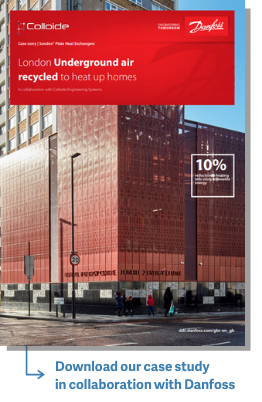The revolutionary, first of its kind in the world, Bunhill 2 Energy Centre.
The scheme provides a blueprint for decarbonising heat in potential future schemes in London and around the world, reducing heating bills and carbon emissions while improving air quality and making cities more self-sufficient in energy.
Benefits [1]:
- Reliable and secure energy supply
- Reduces CO2 emissions by around 500 tonnes each year.
- Reducing heating costs and energy bills for residents to provide a buffer against increasing fuel costs
- Reducing fuel poverty in the borough
- Long-term flexible and expandable solution
- Achieving efficiencies of scale
Colloide Engineering Systems were the main contractor on this scheme and began the construction of the Bunhill 2 Energy Centre back in December 2016.
Paddy McGuinness, Managing Director of Colloide explains: “This project makes use of existing waste heat from the London Underground extraction shaft and harnesses that energy into the district heating network which gets used in the local homes. The main technology used for this is the ammonia heat pump, the pump transfers the warm air into warm water and then subsequently into the district heating network. As a result, this project provides cheaper, greener energy to the local community. We’ve extended the existing heat network on Bunhill and this connects to the new energy centre but it also connects an additional 500 homes to the network.”
As well as delivering additional heating capacity, the Bunhill 2 system provides an innovative cooling solution. The fan in the ventilation shaft has the potential to be reversed to help cool the London Underground network during the summer. Click here to find out more about how it works.
Commissioned by Islington Council, the scheme is an extension of the existing Bunhill 1 network, which was launched in 2012. The new energy centre uses state-of-the-art technology on the site of a disused Underground station that commuters have not seen for almost 100 years. The remains of the station, once known as City Road, have been transformed to house a new 500Kw ammonia heat pump driven by the heat recovery from a heat exchanger coil within a London underground shaft, recovering the warm air lost throughout the northern line tube. Find out more on the challenges we have had to overcome and the final solution for the Bunhill Energy Network.
“TFL (Transport for London) for years have been trying to find ways on how they can reduce the heat on the tubes. So this is a win win situation that we’re able to work collaboratively to reduce the heat issues that TFL have been trying to tackle. So taking the waste heat from the tube allows us to heat the local schools, businesses and homes but also generate cheap heat for our residents“, Karen Agbabiaka, Islington Council’s Head of Public Realm – Highways, Energy and Operational Facilities.
This project is playing an important role in Islington’s commitment to reducing carbon emissions, helping lower heating bills, improving air quality and making the capital more self-sufficient in energy. Islington Council have pledged to work to achieve a net zero carbon Islington by 2030, an ambition that exceeds the national target of 2050 for a net zero carbon UK.
Francis Ugboma, Islington Council’s Head of Energy Services remarks on how this project works towards this target: “By conducting a thorough mapping exercise, looking at all the infrastructure in the borough and at the sources of heat that potentially are there and also the heat loads, we decided that taking waste heat from the underground and connecting it to the existing Bunhill network; thereby extending it and building resilience into the network, was a great way of achieving the council’s aims.”
Many major cities across the UK and around the world have underground railway systems, all of which need to vent heat to ground level, so there is a huge amount of potential for this project to be replicated across the globe. “We want this not only to be replicable here in London, but across the UK and across the world”, Claudia Webbe, Islington Council Executive Member for Environment and Transport.
Find out more about this world-first scheme.
The Bunhill 2 Energy Centre Team
As the main contractor on this scheme, Colloide are extremely proud of what has been achieved alongside our partners Islington Council and Transport for London.
Wider collaboration partners: McGurk Architects | Inner Circle Consulting | AECOM | Ramboll | Gleeds | GEA Group | Danfoss | Firstco | McMahon Associates | Saker International | Wolfsystems | S&P Coil Products | CES Electrical | Grundfos | TES Group | A.J Wells & Sons | Hoval | BSS | Sondex | Logstor | Alpha Tanks | Kamstrup | Donnelly Cabins | ARC Control Systems | Hattersley | Commercial Hot Water Solutions | Trent Energy | NES Architectural | PLS Civil Engineering
Recent news on this project
- https://www.euroheat.org/knowledge-hub/bunhill-heat-power-capturing-waste-heat-london-underground/
- http://www.businesseye.co.uk/ni-firms-london-project-running-national-awards/
- https://www.newsletter.co.uk/business/sustainable-energy-project-heat-pover-1000-london-homes-2956836
- https://www.elementalexpo.com/news/heat-from-the-london-underground-is-being-recycled-for-homes-and-businesses/
Sources:
Photo credits: Paul Raftery Cullinan Studio, Islington Council
Diagram credit: Ramboll
[1] https://www.vitalenergi.co.uk/casestudies/bunhill/
https://www.energyadvice.islington.gov.uk/bunhill-heat-and-power/




